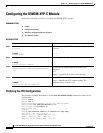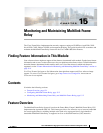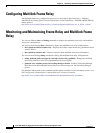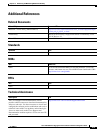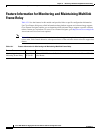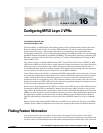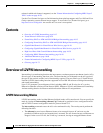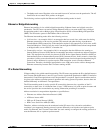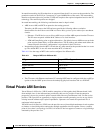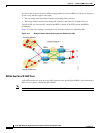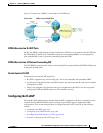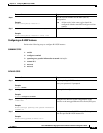
16-2
Cisco ASR 1000 Series Aggregation Services Routers Software Configuration Guide
OL-16506-17
Chapter 16 Configuring MPLS Layer 2 VPNs
Contents
releases in which each feature is supported, see the “Feature Information for Configuring MPLS Layer 2
VPNs” section on page 16-70.
Use the Cisco Feature Navigator to find information about platform support and Cisco IOS and Cisco
Catalyst operating system software image support. To access the Cisco Feature Navigator, go to
http://www.cisco.com/go/cfn. An account on Cisco.com is not required.
Contents
• Overview of L2VPN Interworking, page 16-2
• Virtual Private LAN Services, page 16-4
• Frame Relay DLCI-to-ATM AAL5SNAP Bridged Interworking, page 16-13
• Configuring Frame Relay DLCI-to-ATM AAL5SNAP Bridged Interworking, page 16-15
• Gigabit EtherChannel for Virtual Private Wire Service, page 16-26
• Configuring Gigabit EtherChannel for Virtual Private Wire Service, page 16-28
• High-Level Data Link Control-Ethernet Interworking, page 16-39
• Configuring HDLC-Ethernet Interworking, page 16-40
• Additional References, page 16-69
• Feature Information for Configuring MPLS Layer 2 VPNs, page 16-70
• Glossary, page 16-73
Overview of L2VPN Interworking
Interworking is a transforming function that interconnects two heterogeneous attachment circuits (ACs).
Several types of interworking functions exist. The function that is used depends on the AC type used,
the type of data carried, and the level of functionality required. The two main Layer 2 Virtual Private
Network (L2VPN) interworking functions supported in Cisco IOS XE software are bridged interworking
and routed interworking.
Layer 2 (L2) transport over multiprotocol label switching (MPLS) and IP exists for ACs, such as
Ethernet-to-Ethernet or Point-to-Point Protocol (PPP), Ethernet to VLAN, and Ethernet to Frame Relay.
An interworking function facilitates translation between different L2 encapsulations.
L2VPN Interworking Modes
L2VPN interworking works in either Ethernet (bridged) mode or IP (routed) mode. You can specify the
mode by issuing the interworking {ethernet | ip} command in pseudowire-class configuration mode
and in L2VPN xconnect configuration mode for protocol-based CLI.
The interworking command causes the ACs to be terminated locally. The two keywords perform the
following functions:
• The ethernet keyword causes Ethernet frames to be extracted from an AC and sent over the
pseudowire. Ethernet end-to-end transmission is resumed. The AC frames that are not Ethernet are
dropped. In the case of VLAN, the VLAN tag is removed, leaving an untagged Ethernet frame.



